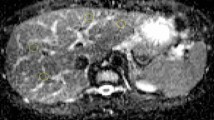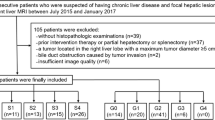Abstract
Objectives
To systematically test the reproducibility of DKI technique in normal liver and report a complete set of DKI measurement data.
Materials and methods
Thirty-two healthy volunteers were examined with liver DKI twice on the GE 3.0 T MRI scanner and reviewed by three professional experts. DKI-derived parameters fractional anisotropy of kurtosis (FAk), mean diffusivity (Md), axial diffusivity (Da), radial diffusivity (Dr), mean kurtosis (Mk), axial kurtosis (Ka), and radial kurtosis (Kr) in eight segments divided by Couinaud octagonal method were collected. Inter-class correlation coefficient (ICC) was used to assess the agreement between three experts. For each expert, the reproducibility of twice scans was evaluated by Bland–Altman method. Multivariate analysis of variance was to explore the regional distribution characteristics of DKI-derived parameters, and showed with box-plot graph.
Results
Using ICC analysis, except for FAk (ICC 0.312, 0.307), other DKI metric values showed high reproducibility (0.716 < ICC < 0.907) between three experts for each of two DKI measurements. With Bland–Altman method, liver segment 5 (S5) showed the best reproducibility between two DKI measurement, and the reproducibility of segment 4 (S4) was the worst. The reproducibility of the right lobe was significantly higher than the left lobe. The values of diffusion metrics (Md, Da, and Dr) and kurtosis metrics (Mk, Ka, and Kr) existed significantly difference between the right and left hepatic lobes.
Conclusion
DKI has shown excellent reproducibility in liver imaging. The range of values for multiple DKI parameters, derived from the normal liver, was reported, and may provide data reference for further clinical DKI applications. Additionally, DKI technique is a non-invasive method to reflect the perfusion or structural differences between the left and right hepatic lobes from the molecular level.


Similar content being viewed by others
References
Jensen JH, Helpern JA, Lu H, Kaczynski K (2005) Diffusional kurtosis imaging: the quantification of non-gaussian water diffusion by means of magnetic resonance imaging. Magn Reson Med 53(6):1432–1440
Jensen JH, Helpern JA (2010) MRI quantification of non-Gaussian water diffusion by kurtosis analysis. NMR Biomed 23(7):698–710
Tan Y, Wang XC, Zhang H et al (2015) Differentiation of high-grade-astrocytomas from solitary-brain-metastases: comparing diffusion kurtosis imaging and diffusion tensor imaging. Eur J Radiol 84:2618–2624
Wu EX (2010) MR diffusion kurtosis imaging for neural tissue characterization. NMR Biomed 23:836–848
Yoshimaru D, Takatsu Y, Suzuki Y et al (2019) Diffusion kurtosis imaging in the assessment of liver function: its potential as an effective predictor of liver function. Br J Radiol 92(1094):20170608
Goshima S, Kanematsu M, Noda Y et al (2015) Diffusion kurtosis imaging to assess response to treatment in hypervascular hepatocellular carcinoma. AJR 204:543–549
Hu G, Liang W, Wu M, Chan Q, Li Y, Xu J et al (2018) Staging of rat liver fibrosis using monoexponential, stretched exponential and diffusion kurtosis models with diffusion weighted imaging-magnetic resonance. Oncotarget 9(2):2357–2366
Yang L, Rao S, Wang W, Chen C, Ding Y, Yang C et al (2018) Staging liver fibrosis with DWI: is there an added value for diffusion kurtosis imaging? Eur Radiol 28(7):3041–3049
Yoon JH, Lee JM, Lee KB et al (2019) Comparison of monoexponential, intravoxel incoherent motion diffusion-weighted imaging and diffusion kurtosis imaging for assessment of hepatic fibrosis. Acta Radiol 60:1593–1601
Wang X, Xue HD, Jin ZY et al (2013) Quantitative hepatic CT perfusion measurement: comparison of Couinaud's hepatic segments with dual-source 128-slice CT. Eur J Radiol 82(2):220–226
Kanda T, Yoshikawa T, Ohno Y, Fujisawa Y, Kanata N, Yamaguchi M et al (2012) Perfusion measurement of the whole upper abdomen of patients with and without liver diseases: initial experience with 320-detector row CT. Eur J Radiol 81:2470–2475
Couinaud C (1999) Liver anatomy: portal (and suprahepatic) or biliary segmentation. Dig Surg 16(6):459–467
Zhuo J, Keledjian K, Xu S et al (2015) Changes in diffusion kurtosis imaging and magnetic resonance spectroscopy in a direct cranial blast traumatic brain injury (dc-bTBI) model. PLoS One 10(8):e0136151
Nasu K, Kuroki Y, Fujii H, Minami M (2007) Hepatic pseudo-anisotropy: a specific artifact in hepatic diffusion-weighted images obtained with respiratory triggering. Magn Reson Mater Phy 20(4):205–211
Filli L, Wurnig M, Nanz D et al (2014) Whole-body diffusion kurtosis imaging: initial experience on non-Gaussian diffusion in various organs. Investig Radiol 49:773–778
Yoshimaru D, Miyati T, Suzuki Y et al (2018) Diffusion kurtosis imaging with the breath-hold technique for staging hepatic fibrosis: a preliminary study. Magn Reson Imaging 47:33–38
Fukunaga I, Hori M, Masutani Y et al (2013) Effects of diffusional kurtosis imaging parameters on diffusion quantification. Radiol Phys Technol 6(2):343–348
Yanqi H, Xin C, Zhongping Z, Lifen Y, Dan P, Changhong L et al (2015) MRI quantification of non-Gaussian water diffusion in normal human kidney: a diffusional kurtosis imaging study. NMR Biomed 28(2):154–161
ter Voert EE, Delso G, Porto M, Huellner M, Veit-Haibach PJIR (2016) Intravoxel incoherent motion protocol evaluation and data quality in normal and malignant liver tissue and comparison to the literature. Investig Radiol 51(2):90–99
Hadrien D, Guido J, Suguru K, Bernd K, Bachir TJEJoR (2014) Intravoxel incoherent motion diffusion imaging of the liver: optimal b value subsampling and impact on parameter precision and reproducibility. Eur J Radiol 83(12):2109–2113
Pasicz K, Podgórska J, Jasieniak J et al (2019) Optimal b values for diffusion kurtosis imaging of the liver and pancreas in MR examinations. Phys Med 66:119–123
Bruegel M, Holzapfel K, Gaa J, Woertler K, Waldt S, Kiefer B et al (2008) Characterization of focal liver lesions by ADC measurements using a respiratory triggered diffusion-weighted single-shot echo-planar MR imaging technique. Eur Radiol 18(3):477–485
Petra M, Sebastian F, Frank TB, Brink JS, Den V, Jürgen G, Schild HH (2002) Abdomen: diffusion-weighted MR imaging with pulse-triggered single-shot sequences. J Radiol 224(1):258
Author information
Authors and Affiliations
Contributions
JW: protocol/data collection/data analysis; WD: protocol/data analysis/project development; HS: protocol/data analysis/project development; HW: protocol/data collection; XH: project development; YG: data collection; HC: protocol/data analysis.
Corresponding author
Ethics declarations
Conflict of interest
The authors each declare that they have no conflict of interest.
Ethical approval
All procedures performed in studies involving human participants were approved by the appropriate ethics committee of the First Affiliated Hospital of Shandong First Medical University.
Informed consent
Informed consent was obtained from all individual participants included in the study.
Additional information
Publisher's Note
Springer Nature remains neutral with regard to jurisdictional claims in published maps and institutional affiliations.
Rights and permissions
About this article
Cite this article
Wang, J., Dou, W., Shi, H. et al. Diffusion kurtosis imaging in liver: a preliminary reproducibility study in healthy volunteers. Magn Reson Mater Phy 33, 877–883 (2020). https://doi.org/10.1007/s10334-020-00846-4
Received:
Revised:
Accepted:
Published:
Issue Date:
DOI: https://doi.org/10.1007/s10334-020-00846-4




